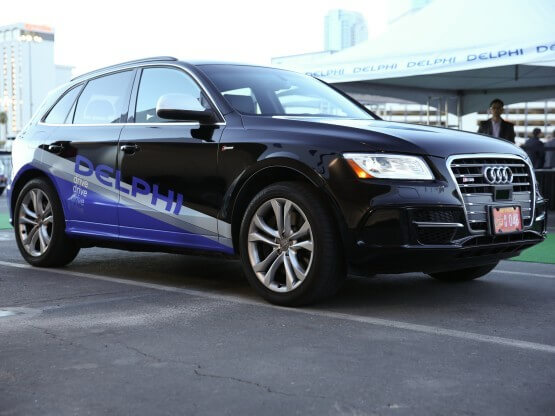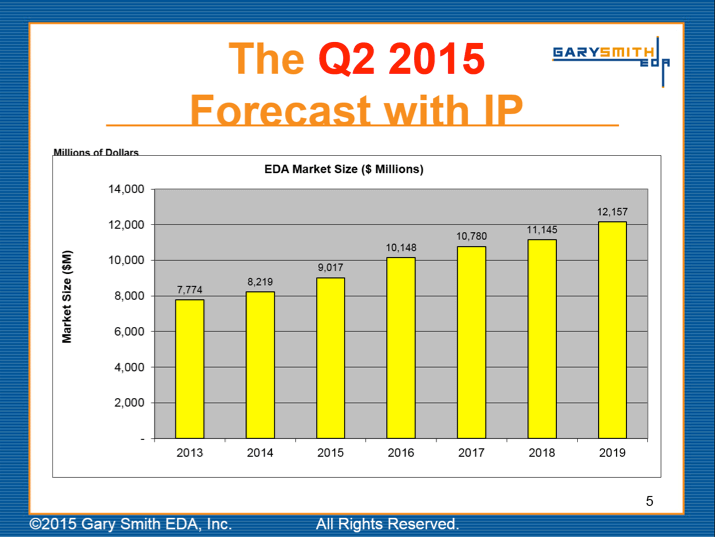By attracting 7011 EDA and IP developers and users, the 52 Design Automation Conference, held in the South Hall of San Francisco’s Moscone Center in the week of June 7, achieved a 14.5% increase in attendees. I was one of them, and started on Sunday evening by listening to Gary Smith’ EDA Forecast presentation. Based on Gary’s and Laurie Blach’s analysis, EDA is likely to grow by 11.2 % annually to reach US $9B by 2019. This prediction includes IP – for which Gary predicted fairly flat revenue of about $3B/year – our industry will grow to $12B.
Gary attributed the flat IP revenues to how difficult it is now to get royalties, and to traditional mega cells being free. However, he is optimistic about the revenue growth of complex platform designs like ARM is offering.
While revenues for PCBs and MEMS are included in his EDA numbers, Gary pointed out that the market for mechanical CAD tools is actually bigger today than for EDA tools and has a very bright future, especially if (when?) both EDA and MCAD developers work together to offer customers a design continuum. Other areas for growth, in Gary’s view, are development tools and IP for ultra-low power applications, optical designs, applications software, and design tools for the fast growing market of electronic devices for the automotive market. Many exhibitors must have come to the same conclusion – or have talked to Gary or Laurie before DAC – because if there was a market-focus at DAC 2015, it was clearly Automotive.
My work on various consulting projects and my 2015 BMW X1 clearly confirm that smart, user-friendly and reliable electronics can add a lot of value to a car, SUV, truck and other vehicles. What I also see is that products for automotive, IoT, even consumers need to address not only multi physics parameters, but also chemical and even biological characteristics.
A perfect example for creating value with a solution that utilizes multiple sciences was Monday’s keynote. Google’s Brian Otis impressed most of us by showing how Google developed a contact lens for diabetics.
Instead of me explaining the deployed mechanical, electrical and biological concepts, I recommend you spend 24 minutes listening to Mentor’s Anne Circle and her introduction of DAC 52. Then enjoy Brian’s 50 minutes presentation about “Google smart lens. IC design and beyond”. You’ll see how much value can be created with inter-disciplinary ideas and development cooperation across multiple sciences.
As I mentioned above, DAC 52 addressed a number of automotive topics, as did Tuesday morning’s keynote.
But before, in the first Tuesday keynote, Intel’s Vivek Singh eloquently addressed: “Moore’s Law at 50: No end in sight” He made very valid points why high-volume applications can and will benefit from 10 and 7 nm technology. Economics will show how high production volume and profit margins need to be, to pay back the development and tooling cost of these advanced technologies.
For the second keynote Jeff Owens, CTO and EVP at Delphi Automotive took the stage and presented: “The design of innovation that drives tomorrow”. Again, follow his presentation at this link, but also allow me to mention a few points I found really educational:
- A premium car today uses 50 computers and 100M lines of code, while an F35 fighter plane “only” needs 24M.
- Delphi employs about 20,000 engineers; 5,000 of them are software engineers
- 100 million cars will be produced worldwide in 2020; 30 million of them in China
- In about 10 years there will be 50% more vehicles on the road worldwide, compared to today
- Currently about 50% of the world population lives in cities; this number will grow to 70% by 2050
- Within the next 10 years China will add 350M urban residents – the current population of the U.S.
These and other technology- and market challenges motivate Delphi Automotive to focus their efforts in three over-arching areas: SAFETY, GREEN and CONNECTIVITY.
- Safety: 90% of accidents happen because of driver error. Technology will help avoiding most of them.
- Green: While 90% of the vehicles in 2040 will rely on combustion engines, their fuel efficiency (~100 miles/g) and emissions reduction measures will make them much cleaner than today’s combustion engine driven cars.
- Connectivity: More and more customers expect to be fully connected in their vehicles, just like they are today in the office and most homes. In addition, cars will communicate with other vehicles on the road, “see and avoid” pedestrians, communicate with a cities’ infrastructures – to avoid traffic jams and find parking, of course park themselves and offer you valet service.
As an example for driver-less car capabilities in future, Owens talked about the Audi Q5 SUV that drove coast to coast, 3400 miles across 15 states in 9 days, and managed 99% of this distance fully automatically.
As Gary Smith said on Sunday evening, EDA has lots of growth opportunities. Hardware and software for the automotive market will be a major one. ~ Herb



















